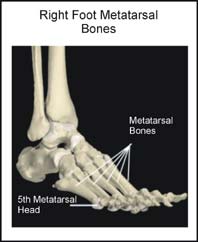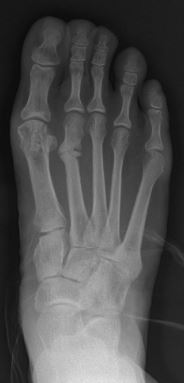In order to understand this condition, it is important to understand the anatomy and function of the foot. Please read Foot Pain Info’s section on basic foot anatomy. For additional background information on the biomechanics of the foot please read Foot Pain Info’s section on basic foot and ankle biomechanics.

What is a stress fracture?
A stress fracture is a “crack” that develops in a bone as a result of excessive or abnormal stress. Bone is a living tissue. It responds to stress by becoming stronger in a process called “remodelling”. If a large amount of stress is placed on a bone suddenly the bone will break. If small amounts of repetitive stress are placed on a bone and this repetitive stress exceeds the bone’s ability to respond, a stress fracture can result.

What is a metatarsal stress fracture?
A metatarsal stress fracture is a stress fracture that develops in one of the metatarsal bones, the longest bones in the foot. Metatarsal stress fractures are also called “march fractures” because they were common in soldiers who did a lot of marching. The second metatarsal bone is the one that is most often affected, followed by the third then the fourth. If left untreated a metatarsal stress fracture can eventually turn into a complete fracture (broken bone).
What does a metatarsal stress fracture feel like?
The pain from a metatarsal stress fracture is usually felt on the top of the foot, over the affected metatarsal bone. The pain can be dull or sharp, constant or intermittent. Pain may persist at rest and may even be severe enough to prevent sleep. There may be tenderness and swelling over the stress fracture. Activities like walking or running can make the pain from a metatarsal stress fracture worse. Hopping or jumping can be particularly painful. If a metatarsal stress fracture progresses to a complete fracture there may be crepitus (a crunching noise) over the fracture site. At this point pain usually prevents weight bearing.
What causes metatarsal stress fractures?
Anything that places excessive or abnormal stress on the metatarsal bones can cause a metatarsal stress fracture. An increase in the frequency, intensity or volume of activity, training on hard or uneven terrain, poor footwear or poor foot biomechanics all may be associated with metatarsal stress fractures. Things that disturb the normal remodelling of bone such as inadequate intake of vitamin D or calcium, medications like prednisone or too much thyroid medication, and some diseases like hyperthyroidism can contribute to the development of a metatarsal stress fracture.
Normal hormone balance is important to bone health. Women with abnormal hormone balance secondary to irregular or absent menstrual periods or excessive weight loss associated with an eating disorder may also be predisposed to developing a metatarsal stress fracture.
Can metatarsal stress fractures be detected on X-rays?
Regular x-rays may only be able to detect advanced stress fractures. A bone scan is a test that is very sensitive in detecting metatarsal stress fractures, including early stress fractures that may not be seen on x-rays. Additional tests such as CT scans or MRI’s are not usually required but may be useful in determining the extent of the stress fracture.
Many conditions may mimic metatarsal stress fractures including Morton’s neuroma, arthritis of the metatarsal phalangeal joints, or injury to the metatarsal heads i.e. osteochondrosis. These conditions require different investigations and treatment.
What is the treatment for a metatarsal stress fracture?
The treatment of metatarsal stress fractures should be individualized. Early stress fractures may only require a short period of rest from the aggravating activity and a change in footwear. Advanced stress fractures may require the use of crutches to take weight off of the foot or a cast to decrease the stress across the affected metatarsal bone. Medications can help ease the pain as can elevating the affected foot. Cardiovascular fitness should be maintained while the stress fracture is healing.
After the stress fracture has healed a gradual return to activity is essential. Strengthening and stretching exercises are important particularly if the foot was immobilized in a cast. The treatment of metatarsal stress fractures also includes addressing any contributing causes. For example, biomechanical problems may be corrected with a change in footwear and shoe orthotics. Nutritional and hormonal deficiencies or irregularities must also be addressed.
What other information is available on metatarsal stress fractures?
Foot Pain Info ‘s links section has additional information on this topic. Links have been provided to other websites as well as online medical journals. Visit Joint Pain Info for information on other joint injuries and problems.
